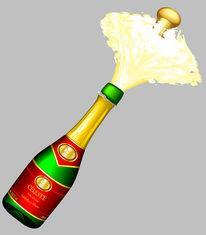
There’s a natural affiliation between the fresh produce and vineyard industries for obvious reasons. Premium English sparkling wine, in particular, can fit in quite nicely with other niche, high-end, labour-intensive crops like asparagus, rhubarb and soft fruit and, grown in the southern climates of the UK, the grape varieties, soil types and general topography means the bouquet is on a par with Champagne.
It is estimated that current plantings of vines in the UK are at the highest ever, at 1,400 hectares, which represents an increase of 50 per cent in five years. Sparkling wine is a winner for the south of England and 45 per cent of the 2009 wine grape harvest in the UK went into the industry, with Chardonnay, Pinot Noir and Pinot Meunier - the varieties used to produce Champagne - accounting for 40 per cent of the total vines planted.
Wine producer Chapel Down Wine’s Frazer Thompson rallied the industry in the summer at Kent’s Fruit Focus event in claiming that English sparkling wine could take 10 per cent of the Champagne sales in the UK. Even at a time where provenance and home production is key, on paper this seems like quite a mission and a substantial percentage of the market to take from such a well established brand. The UK consumers are the biggest purchasers of sparkling wine - after France - so now is the time to strike. However, Champagne’s reputation is well established in the UK and the fact that it is good quality is a given.
But the last 10 years have seen a huge increase in both hobby and professional vineyards in the UK and large wineries such as Chapel Down, Three Choirs Vineyards and Ridgeview are all in place to take the business forward. The industry is set for huge expansion and will produce in excess of five million bottles by 2015. Obviously, success is not just about sheer volume, it’s the quality of the wine that shines through and brings demand. In the last eight years, England has won more awards for its wine than any other country, which is a sign that momentum is building.
So what has this got to do with the fresh produce industry? Many growers have started to dabble in the vineyard business. It seems to be the choice of asparagus growers in particular as it happily sits alongside the specialist produce’s crop rotation. That’s not to say that it’s an easy addition. The Chinn family in Ross-on-Wye, who are long-established asparagus producers, took up the challenge after a bad case of TB in cattle left land on the Herefordshire farm without a purpose. John Chinn has always had an interest in producing wine, ever since his late father - who was the first generation of the Chinns to take up farming on the site - researched the history of the land. As luck would have it for the family’s eventual brand of sparkling wine, Castle Brook, the side of the hill that became vacant was once home to a Roman vineyard and its farmhouse attached is mentioned in the Doomsday Book.
Having a vineyard has to be a passion, says Chris Chinn, who clearly has not only inherited his father’s farming ability, but his enthusiasm for the business as well.
“The two hectare vineyard is a pretty small part of what we do here, but it fits in very well as it is an intensive, time-consuming crop,” says Chris Chinn. “You need a team of people to harvest for two days straight when each variety is ready [in October] and then pruning needs to take place ready for next year. There are so many stages to having a vineyard and then making the wine. The family has been involved at every stage to taste.”
Castle Brook’s Chinn Chinn sparkling wine vintage has been bottled this year, from the family’s 2006 crop of grapes, and will be sold regionally through restaurants and eateries in the Herefordshire area. The brand Castle Brook was officially launched this November at the Orles Barn Hotel.
“The Wye Valley has become a very popular tourist destination and is now a very foodie area,” continues Chris Chinn. “It is also an affluent rural area, where people enjoy the idea of local Herefordshire beef, Wye Valley asparagus and local wine.”
English Wine Producers’ Julia Trustram Eve believes that viticulture in the UK is proving to be an increasingly viable option for all. “Our wines are now proving on the world stage that there is a very real future for this industry in the UK,” she says. “There’s no denying that it takes hard work, investment and long-term dedication, but with the right advice and training a business is achievable.”
But it’s clear you have to know you have a set customer for your vineyard, like any product. “It’s more of a lifestyle choice, although you have to be commercially aware,” says wine producer Ridgeview’s sales and marketing manager Mardi Roberts. “It is a long-term projection, which takes three years to grow and a further three years to reach the market, and we have a lot of growers coming onto the market at the moment.
“The market is expanding, but we now have enough for our capacity. Like anything, you have to be aware of the market already in place.”



